Principles of swarm control
Having introduced swarm prevention last week it’s probably timely to now consider the basic principles of swarm control.
This is going to be relatively high level overview of why swarm control works (which it usually does if implemented properly), rather than a detailed ‘how to’ guide.
That’s because knowing what to do and when to do it is so much easier if you understand why you’re doing it.
That way, when faced with a colony clearly committed to swarming, you can manipulate the colony to avert disaster.
Which it isn’t … though losing a swarm might feel like that to a new beekeeper.
Welcome to the club
All beekeepers lose swarms, even those who rigorously and carefully employ swarm prevention methods. I lost one last year and would have lost another two were it not for a clipped queen in one {{1}} and some particularly unobservant and cackhanded beekeeping with another.
Mea culpa.
However, it’s called swarm prevention because it usually delays and sometimes prevents swarming.
But at some point the enthusiasm of the bees to reproduce often outstrips the possible interventions that can be applied by the beekeeper to the intact colony.
At that point, swarm control becomes necessary.
How do you know when that point has been reached?
Typically, if you carefully inspect the colony on a regular seven day cycle you will easily identify the preliminary stages of swarming. You will then have ample time to take the necessary steps to avoid losing the majority of your bees.
When is swarm control needed?
At some point in late spring {{2}} a colony is likely to make preparations to swarm.
Triggers for this are many and varied.
The colony may be running out of space because the foragers have backfilled the brood box with nectar during a strong spring flow.
Pheromone levels produced by the ageing queen are reducing. These usually act to suppress the formation of queen cells.
Alternatively, although mechanistically similar, the colony may be so populous that the queen mandibular pheromone concentration is – by being distributed to many more workers – effectively reduced. As described last week, in such strong colonies the queen rarely visits the bottom edges of the comb. Consequently, the levels of queen footprint pheromone – another suppressor of queen cell formation – in this region of the nest is reduced.
Whatever the trigger – and there are probably others – the colony starts producing queen cells.
Sometimes these are very obvious, decorating the lower edges of the drawn comb.
At other times they are hidden in plain sight … in the middle of the comb, with a moving, wiggling, shifting, dancing curtain of bees covering them {{3}}.
The production of queen cells indicates that swarm prevention has not been successful and that swarm control is now needed.
More specifically, it is the production of charged queen cells with a larva sitting in a deep bed of Royal Jelly, that indicates prompt swarm control is required.
And remember, there may well be more than one queen cell and they are not always on the same frame.
Unsealed and sealed queen cells
With experience you can ‘age’ queen cells by their size and appearance. The larva in the queen cell in the photo above hatched from the egg about 3-4 days ago.
When the larva is five days old the cell will be sealed and the larva pupates {{4}}.
In a further 8 days i.e. 16 days after the egg was originally laid in the cell, the new virgin queen will emerge.
But the colony will have already swarmed.
That is because, under normal circumstances, a colony usually swarms on the day that the queen cell is sealed.
There are two events that often delay swarming beyond the day that the queen cell is sealed.
The first you have no control over. It’s the weather. Colonies usually swarm on lovely warm, sunny days. If it’s cold and wet, or blowin’ a hoolie, the swarm will wisely wait for a day with better weather. Wouldn’t you?
If you have a week of poor weather in mid/late May (the peak swarming season around here at least) then the first day of good weather is often chaos with swarms all over the place 🙂
Swarmtastic!
The second thing that delays swarming is if the old queen has a clipped wing. In this instance the swarm usually waits until the new queen emerges before trying to leaving the colony.
The other event, less routine in my experience, that stops swarming {{5}} is supercedure. In this, the queen is replaced in situ, without the colony swarming. Queen cells are still produced, usually rather few in number {{6}}. I’ll discuss supercedure at some point in the future.
Destroying queen cells is not swarm control
If you simply destroy developing queen cells the colony will eventually swarm.
Either you’ll miss a queen cell – and they can be very hard to spot in a busy colony – or the bees will start one from an older larva and the colony will swarm before your next 7 day inspection.
Beekeeping is full of uncertainties. That’s why these pages are littered with caveats or adverbs like ‘usually’. However, ‘the colony will eventually swarm’ needs no such qualification. If all you do is knock back queen cells you will lose a swarm.
I said in the opening section that losing a swarm is not a disaster, though it might feel that way to a beginner.
In reality, for a beekeeper who thinks destroying queen cells is a form of swarm control, losing a swarm can be a disaster {{7}}.
When is ‘not a disaster’ actually a disaster?
Here’s the scenario … on one of your regular inspections (delayed a week because of a long weekend in Rome {{8}}) you open the hive and find half a dozen fat, sealed queen cells decorating the lower edges of a couple of frames.
Using your trusty hive tool you swiftly obliterate them.
Job done 😀
But wait … under normal circumstances when does the colony usually swarm?
On the day the queen cell is sealed.
That colony had already swarmed 😥
What’s more, it may well have swarmed several days ago. Therefore there will no longer be any eggs or very young larvae in the hive that could be reared as new queens. Without acquiring a new queen (or a frame of eggs and young larvae) from elsewhere that colony is doomed 😥
So … repeat after me … destroying queen cells is not swarm control.
If they are sealed, the colony has probably swarmed already and destroying all that are there jeopardises the viability of the colony.
If they are not sealed, then destroying them will not stop them making more and you will miss one tucked away in the corner of a frame.
And the colony will swarm anyway.
Generally, destroying all the queen cells in a colony is a lose-lose situation 🙁
The principles of swarm control
Disappointingly, almost none of the above has been about the principles of swarm control {{9}}. However, the point I make about colony viability allows me to get back on topic in a rather contrived manner 😉
When a colony swarms, ~75% of the adult bees and the mated, laying queen fly away.
They leave behind a much depleted hive containing lots of stores, some sealed brood, some larvae, some eggs and one or more sealed queen cells.
Swarming is colony reproduction. Therefore, both the swarm and the swarmed colony (the bits that are left behind) have the potential to form a new fully viable colony.
The swarm needs to find a new nest site, draw comb, lay eggs and rear foragers. The swarmed colony needs to let the new queen(s) emerge, for one queen to get mated and return to the hive and start laying eggs.
But importantly these events take time. Therefore, neither the swarm nor the swarmed colony are likely to swarm again in the same season.
And that, in a nutshell, describes the two defining features of many types of swarm control:
- the colony is manipulated in a way to retain its potential to form a viable colony
- the colony is unlikely to swarm again until the following season
So, which parts of the hive population have the potential to form a viable colony?
The bees in the colony
A colony contains a mated, laying queen. The thousands of eggs she lays are part of the developing workforce of larvae and pupae, all of which are cared for by the very youngest adult workers in the hive, the nurse bees. Finally, the third component of the colony are the so-called flying bees {{10}}, the foragers responsible for collecting pollen and nectar.
Of those three components – the queen, flying bees, and the combination of developing bees and nurse bees – only the latter has the potential to form a new colony alone.
The queen cannot, she needs worker bees to do all the work for her.
The flying bees cannot as they’re unmated and cannot therefore lay fertilised eggs.
But if the combination of nurse bees and developing brood contains either eggs or very young larvae they do have the potential to rear a new queen and so create a viable colony.
Furthermore, thanks to their flexible temporal polyethism {{11}} the combination of the queen and the flying bees also has the potential to create a viable colony.
Divide and conquer
The general principle of many swarm control methods {{12}} is therefore to divide the colony into two viable parts:
- The queen and flying bees – recapitulating, though not entirely, the swarm {{13}}. We’ll call this the artificial swarm.
- The developing brood and nurse bees. This component must contain eggs and/or very young larvae from which a new queen can be reared {{14}}. We’ll call this the artificially swarmed colony.
I’ve described two very standard swarm control methods in detail that fit this general principle.
- The Pagden artificial swarm, probably the standard method taught to beginners up and down the country.
- The vertical split, which is a less resource-intensive variant but involves more heavy lifting.
Both initially separate the queen on a single frame and then exploit the exquisite homing ability of the flying bees to separate them from the nurse bees/brood combination that have been moved a short distance away.
Both methods are effective. Neither is foolproof.
The artificially swarmed colony almost always raises multiple new queen cells once it realises that the original queen has gone. If the initial colony was very strong there’s a good chance several queens will emerge and that the colony will produce casts – swarms headed by virgin queens.
To avoid this situation (which resembles natural cast production by very strong colonies) a second move of the artificially swarmed colony is often used to reduce further the number of flying bees {{15}}, and so weaken the colony sufficiently that they only produce a single queen.
Alternatively, the beekeeper does this manually, by removing all but one queen cell in the artificially swarmed colony.
And the nucleus method?
Astute readers will realise that the nucleus method of swarm control is similar but different.
It separates the colony into two viable parts but there is no attempt to separate the majority of the flying bees from the brood/nurse bees.
I like the nucleus method of swarm control. It’s easy to understand, very simple to implement and – done properly – very effective.
In particular, I think it is an easier method for beginners to grasp … in a “remove the queen and the colony cannot swarm” sort of way {{16}}.
However, the queenless part of the split colony is inevitably left relatively strong, with brood, nurse bees and a lot of the flying bees. As a consequence there’s a good chance it will produce cast swarms if it’s allowed to rear multiple queens to maturity.
Which is why you must inspect the queenless part of the split colony one week later. As I said in my original post on this method:
The timing and thoroughness of this inspection is important. Don’t do it earlier. Or later. Don’t rush it and don’t leave more than one queen cell.
Which neatly introduces nucleus colonies which is the topic for next week 😉
{{1}}: So I’d perhaps argue that my prevention and control worked, though only because the swarm ended clustered under the open mesh floor and was successfully re-hived.
{{2}}: Like all things in beekeeping it’s not possible to be precise about dates – it varies depending upon geography, season, climate and weather.
{{3}}: This one is also pretty obvious – slightly right of the centre of the photograph. Now look again. There’s another one as well. If you look very carefully you’ll also see that the uncapped cells are filled with nectar – this colony has run out of room as the foragers have been backfilling the centre of the broodnest.
{{4}}: Queen cell development is very fast – 3 days as an egg, 5 days as a larva, 7-8 days as a pupa, with emergence on day 16 after egg laying.
{{5}}: Pedantically it doesn’t start in the first place.
{{6}}: I’m not convinced you can dependaby differentiate supercedure queen cells from swarm queen cells by their appearance or position. If you find queen cells you have to consider swarm control.
{{7}}: I’m using the term disaster in the context of beekeeping, not global viral Armageddon. These things are relative.
{{8}}: Or a family wedding, or a conference … or one of any number of things that used to happen before Covid-19.
{{9}}: Other than to emphasise that destroying queen cells is not swarm control.
{{10}}: These are workers usually from about 2-3 weeks old – effectively middle age for a bee in midsummer.
{{11}}: Bees of different ages have different roles and responsibilities in the hive. However, there is some flexibility in this. Older workers can revert back to fulfill the duties in of younger bees if needed.
{{12}}: Like smoker fuel or hive tools, there are many, many methods of swarm control, most of which work. Many work on the principles defined here. Some do not.
{{13}}: A natural swarm contains worker bees of all ages, and is not just predominantly the older workers.
{{14}}: Which is why knocking back all the sealed queen cells in a colony with no eggs or young larvae is usually a disaster.
{{15}}: This move is done a week after the initial division of the hive, after which time there are no more young larvae or eggs to be reared to make new queens.
{{16}}: Though that’s not actually correct …
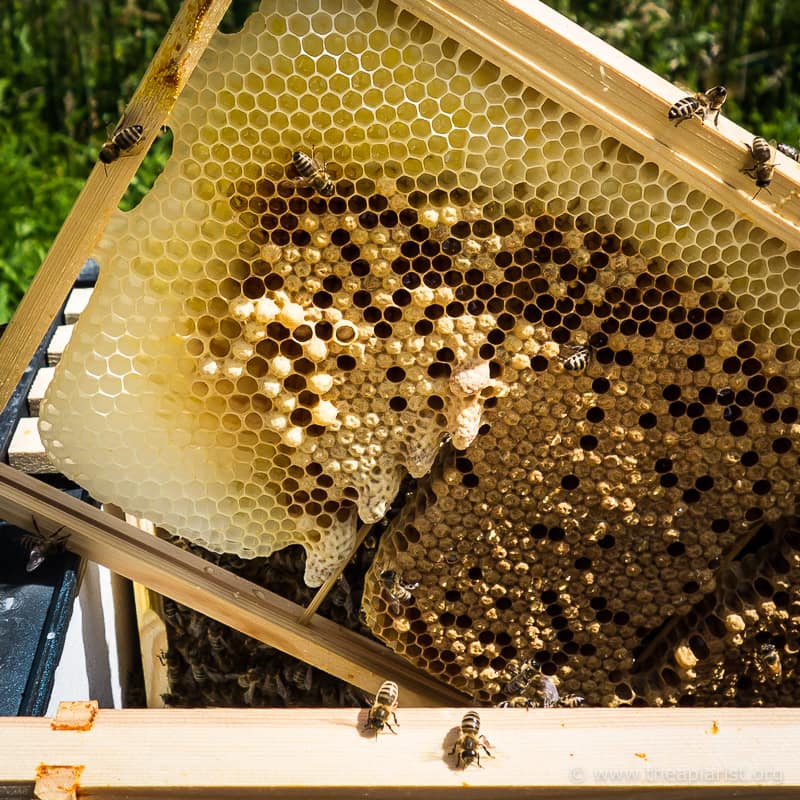
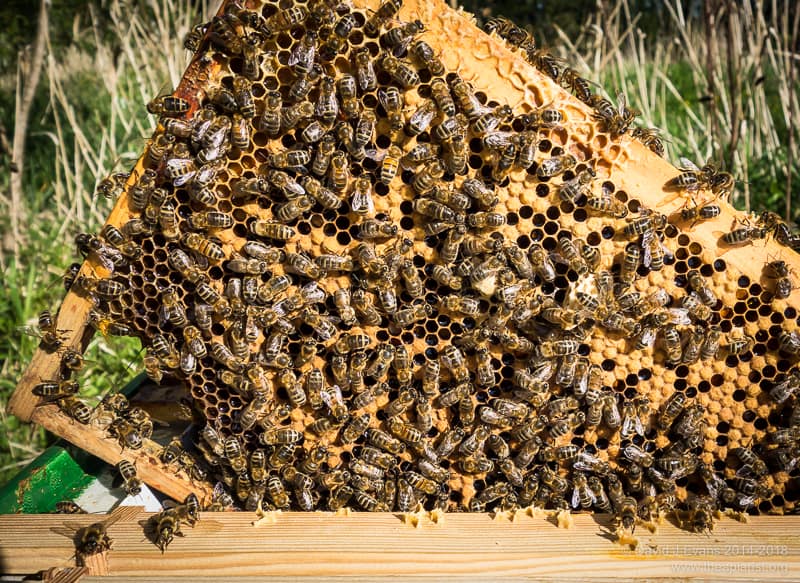
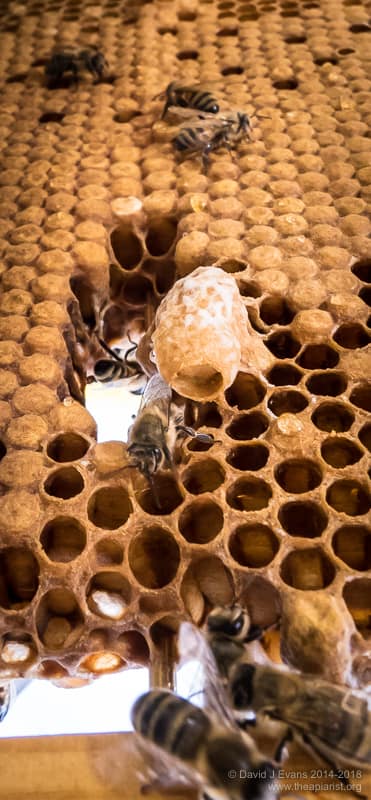
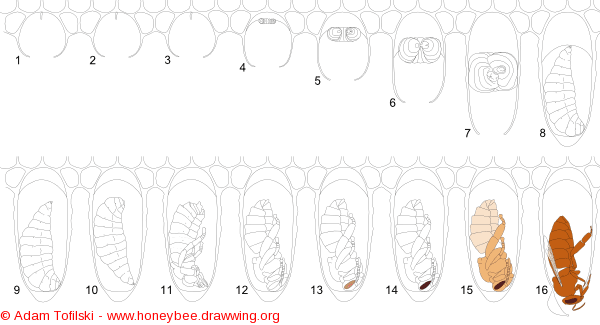
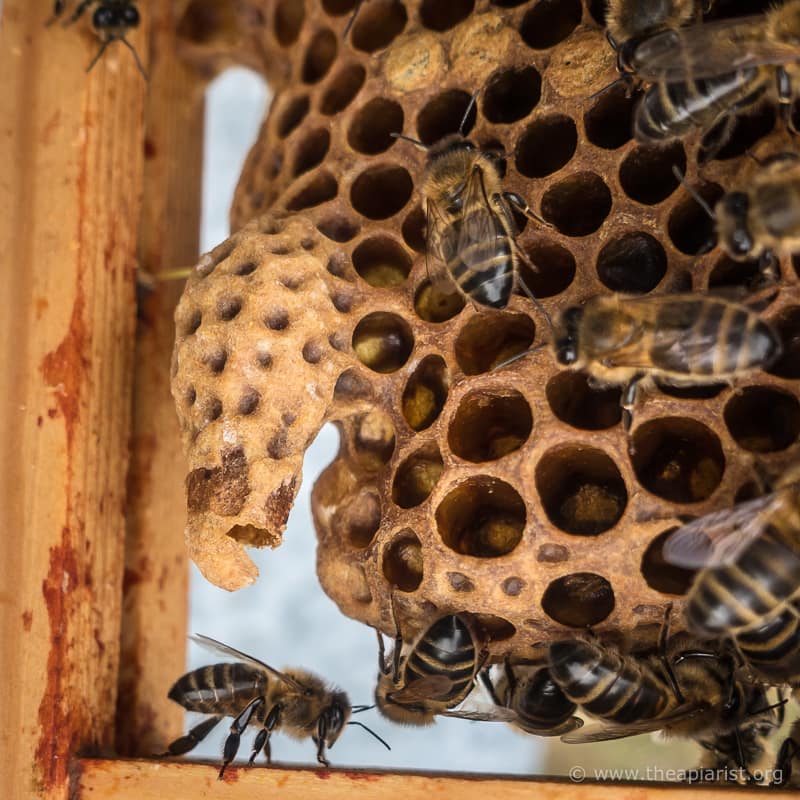
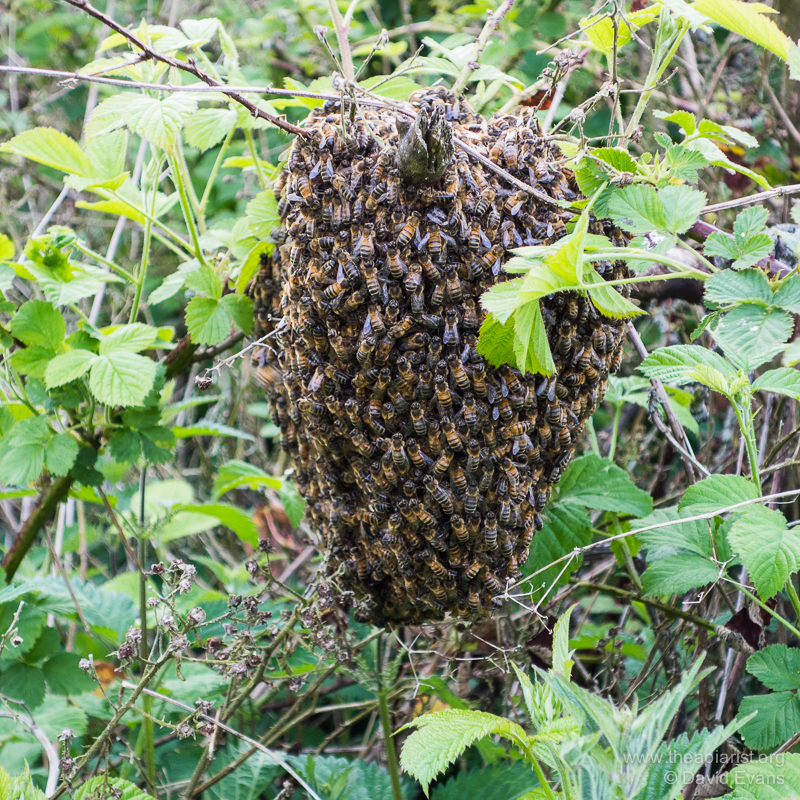
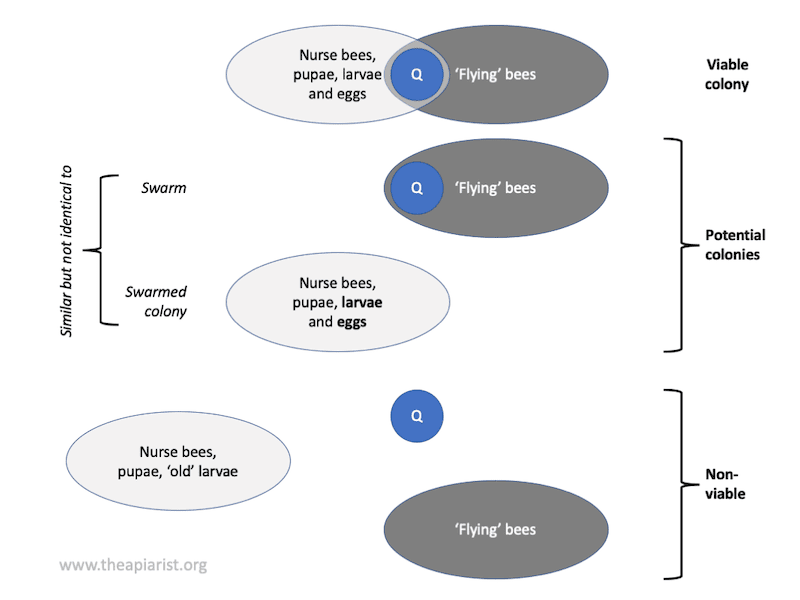
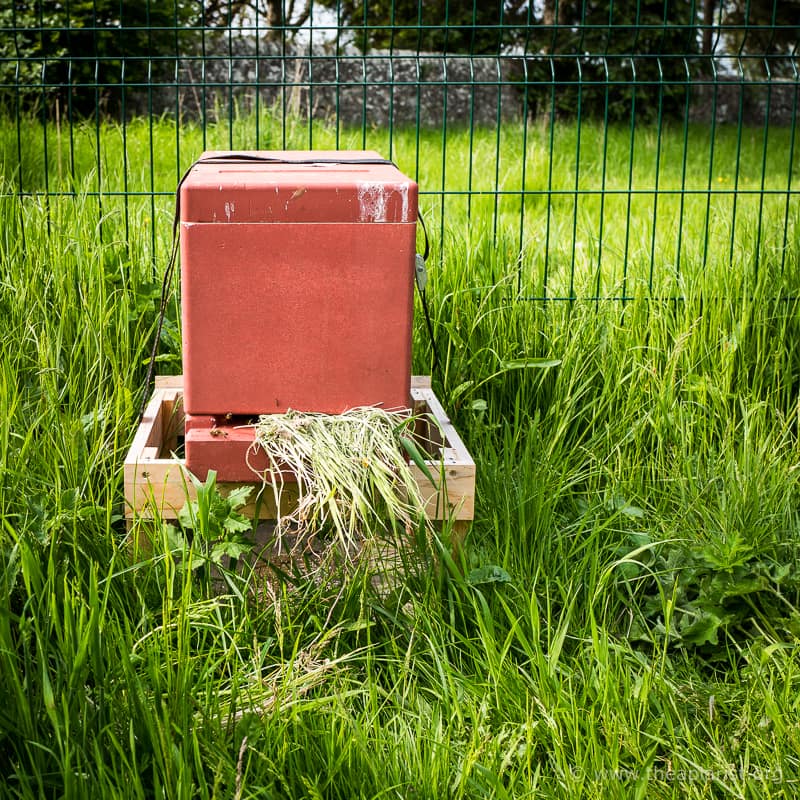
Join the discussion ...